The LAIT project has been selected as one of ten proposals to be developed on behalf of the Illinois Learning Sciences Design Initiative (ILSDI). Facilitated by the College of Education, this initiative features the work of emerging technologies being developed on-campus by competing teams of interdisciplinary researchers.
This fall, LAIT collaborators are working on two fronts to make the project more robust. The technical team is increasing the modes of communication between audience and facilitator. The aesthetics team is writing a conceptual reflection of LAIT’s potential, outlining future applications and thematic considerations. In November, the aesethetics and technical team will put forth a proposal for deploying LAIT in educational settings, both in the classroom and beyond.
The goal of ILSDI is to foster collaboration among different departments and make use of Illinois’ outstanding faculty and research facilities. At the kickoff luncheon on September 18, 2015 John Toenjes outlined the current status of LAIT’s technical capabilities.





